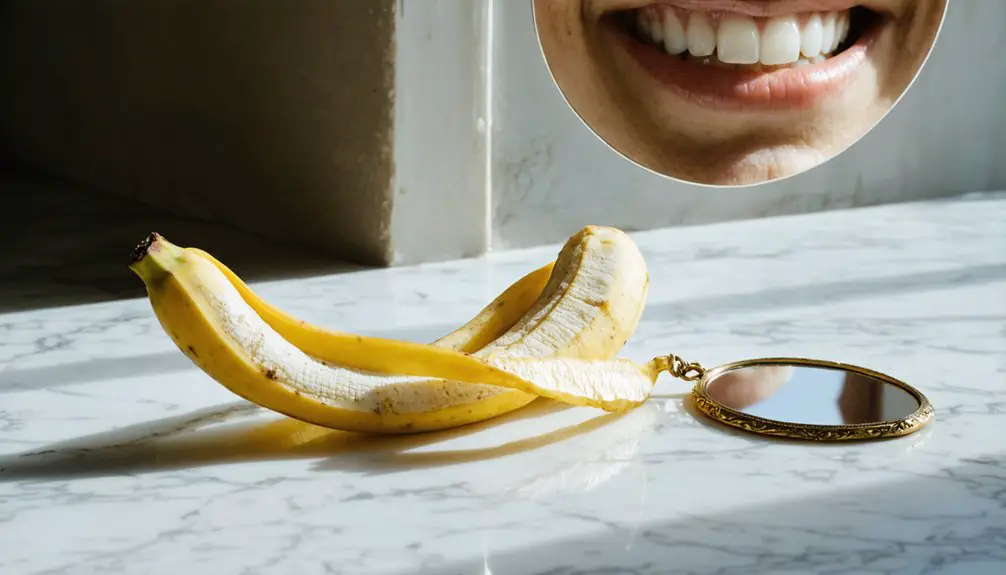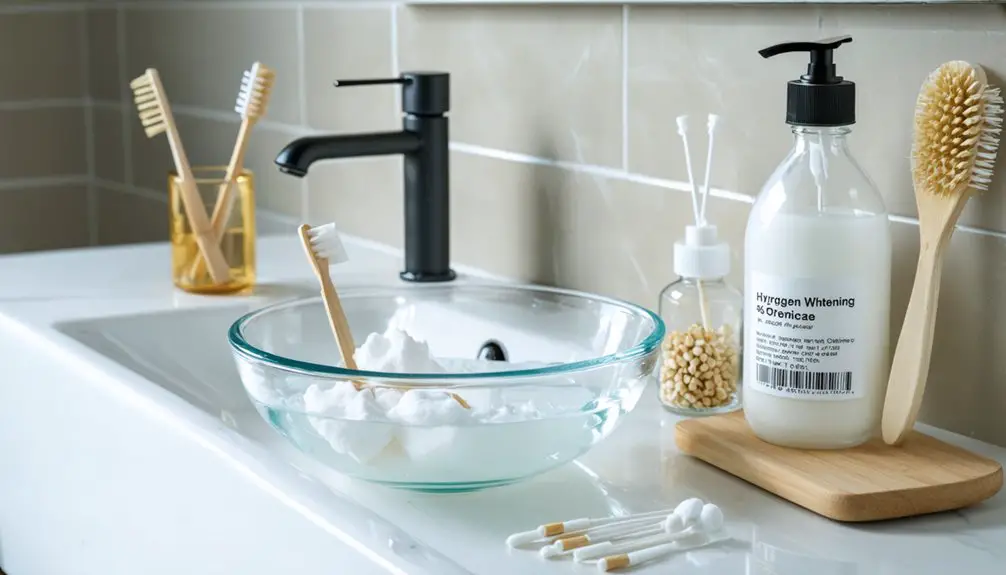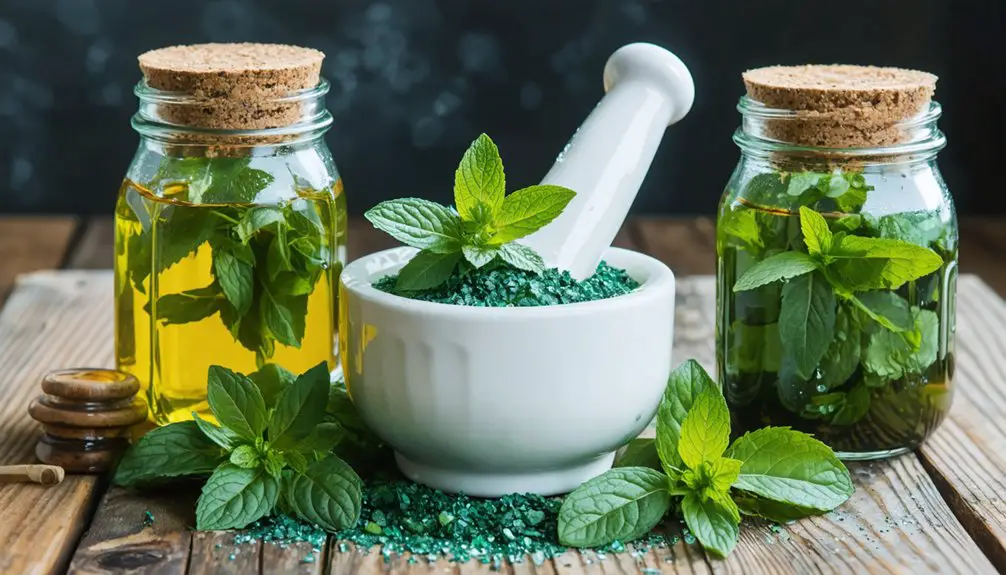While banana peels contain minerals like potassium and magnesium that could theoretically help strengthen tooth enamel, scientific research doesn’t support their effectiveness for teeth whitening. You’ll find compounds like flavonoids and saponins in the peels that may bind to stain-causing molecules, plus their mildly abrasive texture could help remove surface plaque. However, clinical studies show minimal color changes compared to proven professional methods. Understanding the full picture can help you make an informed choice about teeth whitening options.
Key Takeaways
- Banana peels contain minerals like potassium and magnesium that can help strengthen tooth enamel and improve overall dental health.
- The natural compounds in banana peels, including flavonoids and saponins, may help bind to and remove surface stains.
- Banana peels offer a gentle, chemical-free alternative to traditional whitening methods with zero documented cases of allergic reactions.
- The mildly abrasive texture of banana peels can help remove surface plaque while maintaining a neutral pH that won’t damage enamel.
- Users can control application pressure and duration for personalized comfort, though results are less effective than professional whitening treatments.
The Science Behind Banana Peel Properties
While many people discard banana peels without a second thought, these often-overlooked fruit casings contain a remarkable array of compounds that may benefit dental health.
Beyond being mere fruit waste, banana peels pack powerful compounds that could be nature’s secret weapon for better dental care.
You’ll find rich deposits of potassium, magnesium, and manganese that work together to strengthen tooth enamel and combat decay-causing acids. The peels’ phytochemical benefits stem from their abundance of alkaloids, flavonoids, phenols, and saponins – compounds that actively bind to stain-causing molecules on your teeth.
The mineral roles become even more significant as bananas ripen, with increased levels of potassium and magnesium enhancing potential whitening effects. For optimal results, use ripe yellow peels during application. The peel’s mildly abrasive texture can help remove surface plaque and stains when gently rubbed against teeth.
What’s particularly remarkable is the peel’s neutral pH of 6.7, which means you won’t risk enamel erosion while pursuing a brighter smile through this natural approach.
What Research Says About Effectiveness
You’ll find that clinical studies offer little support for banana peels as an effective teeth whitening solution, with research showing minimal to negligible color changes compared to conventional whitening products.
Professional dental evaluation shows that deeper stains require professional treatment for meaningful whitening effects.
Research indicates that teeth may become more yellow from banana peel usage.
Laboratory testing reveals that banana peels’ natural compounds, while offering antimicrobial benefits, lack the chemical properties necessary for significant bleaching action.
The real-world impact of using banana peels for teeth whitening falls short of both professional treatments and over-the-counter whitening products, often producing results no better than regular brushing.
Clinical Evidence Shows Limited
Despite widespread anecdotal claims about banana peel teeth whitening, scientific research has shown limited clinical evidence supporting its effectiveness.
Large-scale clinical studies comparing banana peel to proven whitening agents like hydrogen peroxide have found minimal to no significant results. Many clinical misconceptions stem from anecdotal evidence rather than controlled research, as no studies have demonstrated a clear whitening mechanism. The American Dental Association has not approved this method for teeth whitening.
The slight changes some people observe may simply result from removing surface debris rather than actual bleaching.
Professional dental guidance remains essential for safe and effective whitening results.
More concerning is that banana peels contain natural sugars that could promote tooth decay if not properly removed.
You’ll find most dental professionals recommend sticking with clinically-proven whitening methods, as banana peel treatment lacks both the scientific validation and standardized application protocols needed for reliable results.
Laboratory Testing Results
Laboratory research offers a more nuanced perspective on banana peel whitening than anecdotal reports suggest. Under controlled laboratory conditions, studies demonstrate that banana peel extracts can reduce tooth staining, though less dramatically than chemical alternatives like hydrogen peroxide.
Scientists have identified specific compounds, including saponins and flavonoids, that appear to bind with and remove chromogens from tooth surfaces.
Testing typically involves comparing stained teeth treated with banana peel extracts against chemical whiteners and control groups. Experimental variables include treatment duration and extract concentration, with longer exposure times producing better results.
While the whitening effect is moderate, banana peel extracts offer additional benefits through their antimicrobial properties and gentle pH levels, which help protect enamel integrity during the whitening process. Although minerals like potassium and manganese are present in banana peels, their direct impact on tooth whitening remains unproven by scientific research.
Real-World Whitening Impact
Scientific research challenges the popular belief that banana peels whiten teeth effectively. Controlled studies have found no significant bleaching effect, with p-values of 0.61 indicating statistically negligible results.
In fact, some test samples showed teeth becoming yellower and less lustrous after banana peel application.
Real world outcomes consistently demonstrate that traditional whitening methods, like hydrogen peroxide gels and professional treatments, far outperform banana peels. The high mineral content of bananas, including potassium and magnesium, does not translate to effective tooth whitening.
While user experiences shared on social media often claim success, these testimonials typically confuse general oral hygiene improvements with actual tooth color changes.
The mild abrasive texture of banana peels may remove surface plaque, but it doesn’t match the effectiveness of regular brushing or whitening toothpaste.
The American Dental Association doesn’t endorse this method due to lack of proven results.
Safety Profile Compared to Other Methods
While you might be tempted to try banana peels as a natural teeth whitening method due to their lower acidity compared to citrus fruits, professional dental treatments remain the most reliable and scientifically-proven option.
Professional whitening methods, performed under dental supervision, use controlled concentrations of bleaching agents that deliver predictable results without risking your enamel health. Since no scientific proof exists showing banana peels can effectively whiten teeth, relying on this method may waste valuable time. Maintaining good oral hygiene habits is essential for preventing plaque buildup and tooth discoloration.
Unlike banana peels which lack scientific evidence for effectiveness, professional treatments offer customized approaches based on your specific dental conditions and provide rapid, visible results with minimal risk.
Low-Risk Natural Alternative
Although conventional teeth whitening methods often rely on harsh chemicals, banana peel offers a gentler approach with a particularly lower risk profile. This natural whitening alternative allows you to maintain good oral hygiene while avoiding common issues like tooth sensitivity and gum irritation associated with traditional bleaching agents.
- No harsh peroxides or chemical agents that could cause burns or tissue damage
- You control the application pressure and duration for personalized comfort
- Zero documented cases of allergic reactions or systemic toxicity
- Safe for frequent use without risking enamel erosion or dentin exposure
- Compatible with dental restorations, unlike some chemical whiteners
The minimal abrasiveness of banana peel makes it particularly suitable if you’re prone to sensitivity or have experienced adverse reactions to conventional whitening products.
Professional Grade Comparison
Despite its natural appeal, banana peel whitening lacks the rigorous safety protocols and clinical validation found in professional dental treatments.
While banana peel benefits include minimal risk of enamel damage, they don’t match the documented effectiveness of dentist-supervised procedures using proven whitening agents like hydrogen peroxide.
Professional recommendations emphasize the importance of controlled treatments tailored to your specific dental needs.
Unlike banana peels, which offer no standardized application method, professional whitening provides custom-fit trays, precise agent concentrations, and expert monitoring to guarantee both safety and results.
You’ll also benefit from pre-treatment evaluations that identify potential risks or underlying conditions that could affect your whitening outcomes.
The controlled environment of professional treatment delivers predictable, measurable results that banana peel applications simply can’t match.
Common Myths Vs Reality
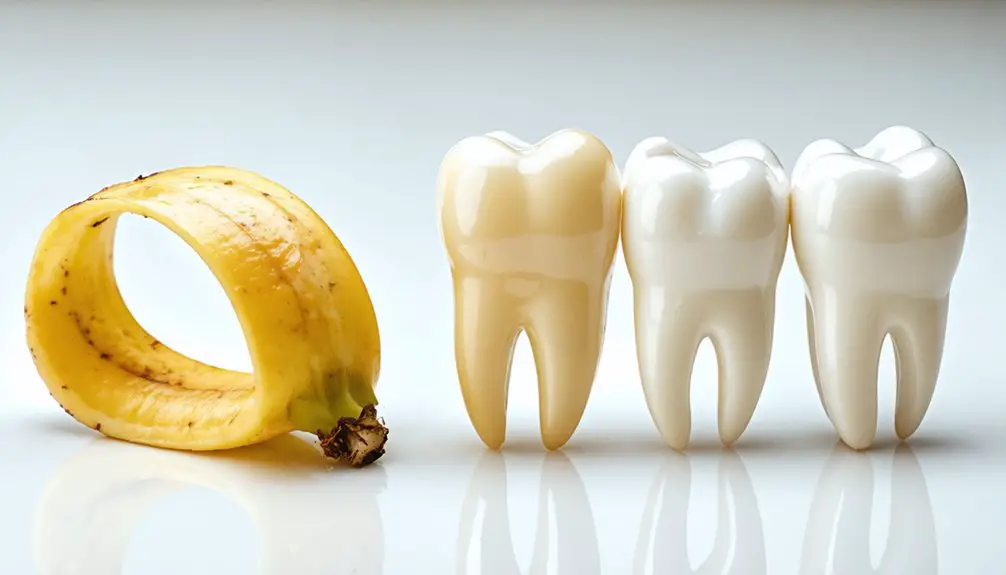
As social media trends continue promoting banana peels for teeth whitening, it’s important to separate scientific facts from popular misconceptions.
While banana peels contain minerals like potassium and magnesium, scientific studies have found no conclusive evidence supporting significant whitening effects. You might notice minimal surface stain removal due to gentle abrasion, but this doesn’t compare to professional whitening methods.
- Studies show banana peels may actually leave teeth yellower and less shiny
- Natural sugars in banana residue could contribute to tooth decay
- The abrasive action is weaker than regular brushing with toothpaste
- No standardized instructions exist for safe application
- Professional whitening remains the only scientifically-proven method for reliable results
Practical Application Tips
While scientific evidence doesn’t support banana peels for teeth whitening, many still choose to try this method. If you’re considering this approach, it’s crucial to follow proper application techniques for ideal safety and potential benefits.
Use the white inner part of a fresh, ripe banana peel and gently rub it on your teeth for 2-5 minutes. Incorporate this into your daily routine, ideally before brushing. Apply consistent, light pressure to avoid irritating your gums.
Always rinse or brush afterward to remove residual sugars that could promote decay. For best results, maintain this practice for 1-2 weeks, with possible twice-daily applications if comfortable.
Remember to use clean, fresh peels and discard any that show signs of aging or discoloration.
Better Alternatives for Whiter Teeth
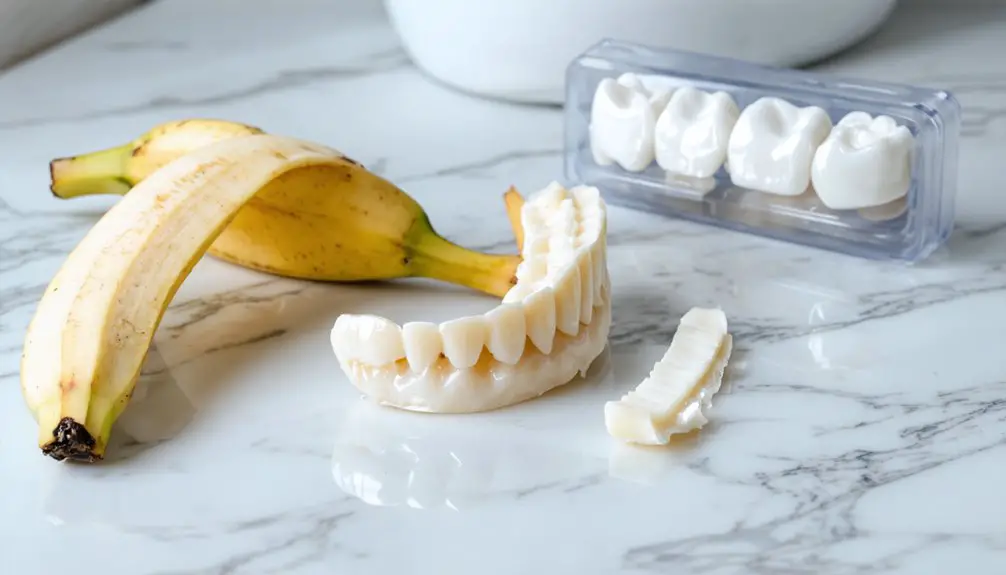
Looking for more reliable teeth whitening methods than banana peels? While natural remedies have their appeal, proven cosmetic dentistry options deliver predictable results for a brighter smile.
- Professional in-office whitening treatments offer dramatic results in just 30-60 minutes, lightening teeth up to 8 shades with effects lasting 1-3 years.
- At-home whitening kits provide gradual improvement over several weeks, brightening teeth 3-6 shades using lower-strength peroxide formulas.
- Whitening toothpastes and rinses help maintain results and remove surface stains through gentle daily use.
- Porcelain veneers create permanent, stain-resistant solutions while correcting other aesthetic concerns.
- LED-accelerated systems combine convenience with enhanced results through advanced technology.
You’ll find these scientifically-backed methods more effective than unproven techniques, with treatments tailored to your specific needs and sensitivity levels.
Frequently Asked Questions
How Long Should I Leave Banana Peel on My Teeth?
You shouldn’t leave banana peel on your teeth longer than 2-5 minutes to minimize teeth sensitivity. While some suggest 10-minute whitening duration, there’s no scientific evidence supporting extended application times.
Can I Reuse the Same Banana Peel Multiple Times?
You shouldn’t reuse banana peels for teeth whitening benefits, as minerals deplete after first use. Each application requires a fresh peel to maintain effectiveness and prevent bacterial contamination.
Should Banana Peels Be Ripe or Unripe for Teeth Whitening?
Like mining precious minerals, you’ll extract more benefits from ripe yellow banana peels. They’re higher in whitening minerals than unripe ones, making them considerably more effective for teeth whitening applications.
Will Banana Peel Whitening Work on Dental Crowns or Veneers?
You won’t see whitening effectiveness on dental crowns or veneers with banana peels since these dental restorations aren’t porous like natural teeth, making them resistant to whitening limitations of any method.
Can I Combine Banana Peel With Other Natural Whiteners?
You’re barking up the wrong tree. Combining banana peels with coconut oil or baking soda isn’t recommended, as these mixtures lack scientific evidence and may risk damaging your tooth enamel.
References
- https://www.jaxdentalstudio.com/do-banana-peels-whiten-teeth
- https://annalsofdentalspecialty.net.in/storage/files/article/83b6cc51-f84f-442d-b1d8-a231602a81af-toHVimrVFAhHQrrW/wKcqtN4WWpQ1lgO.pdf
- https://www.ortegacottagedentistry.com/banana-peel-teeth-whitening-will-it-give-you-a-brighter-smile/
- https://health.medicaldialogues.in/fact-check/fact-check-can-banana-peel-turmeric-and-toothpaste-completely-whiten-teeth-in-34-uses-142699
- https://www.rejuv-health.com/cosmetic-dentistry/banana-peel-teeth-whitening/
- https://dentistryforyoubrokenarrow.com/can-you-whiten-your-teeth-with-banana-peels/
- https://dentistryforyoubrokenarrow.com/banana-teeth-whitening/
- https://www.yourmckinneydentist.com/do-banana-peels-whiten-teeth-guide-by-cosmetic-dentist/
- https://pmc.ncbi.nlm.nih.gov/articles/PMC10024105/
- https://pmc.ncbi.nlm.nih.gov/articles/PMC9645194/
